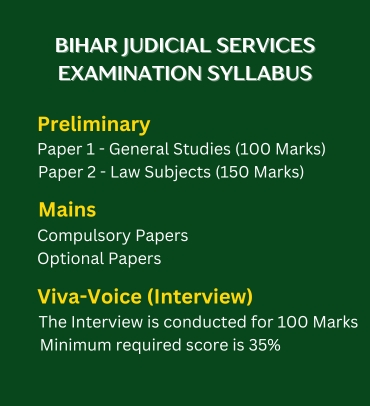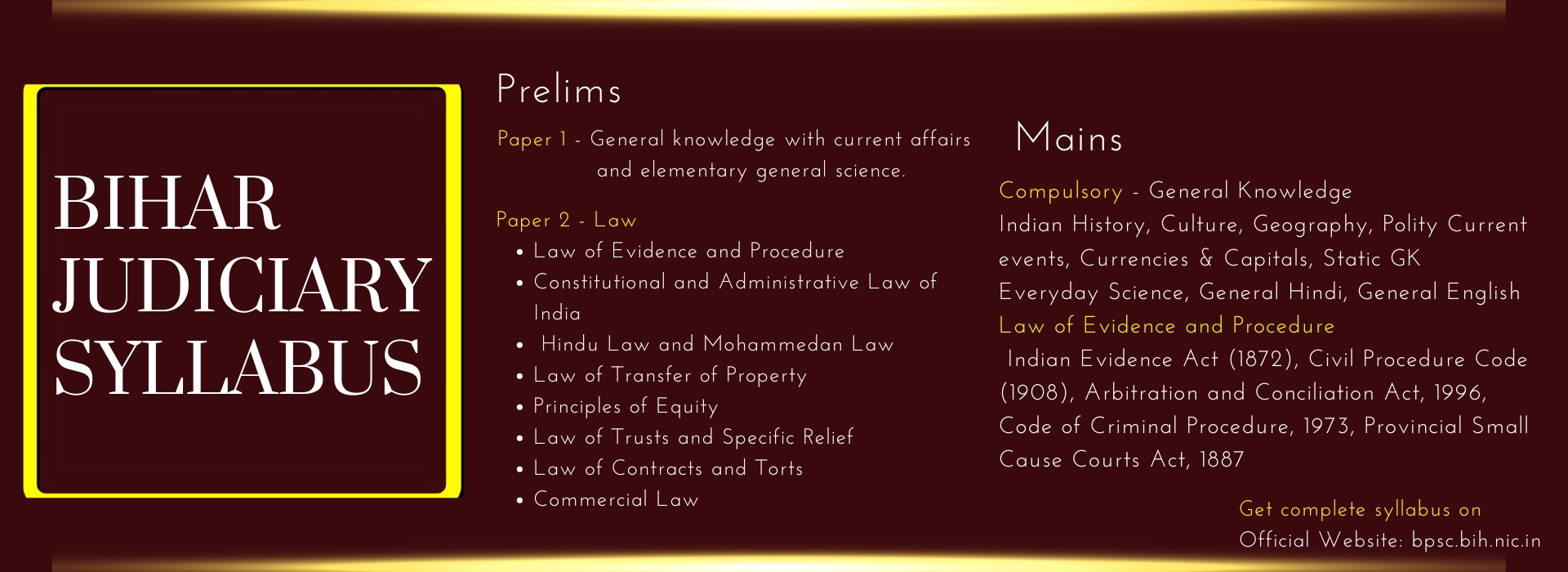.jpg)
Judiciary Syllabus Overview
As the top Bihar judiciary coaching in Patna, we understand the judiciary exam syllabus from start to finish. We know that breaking down the syllabus and understanding the study pattern for each topic is key to success. Here’s a guide to the core topics you’ll encounter in the judiciary exams, along with our approach to studying each.
1. Indian Penal Code (IPC)
Overview: This covers criminal laws, including essential topics such as general exceptions, punishments, offenses against the state, and more.
Study Pattern:
- Basic Principles: Start with general concepts like crime, criminal liability, and exceptions. We simplify legal jargon, so you grasp these basics clearly.
- Section-Wise Coverage: We dive into sections like IPC 302 (Murder) and IPC 304 (Culpable Homicide), detailing every key section with case law examples.
- Mock Case Analysis: We bring in real-life case studies to help understand complex IPC sections.

2. Code of Civil Procedure (CPC)
Overview: CPC regulates civil court procedures, covering filing suits, judgment execution, appeals, and the structure of civil trials.
Study Pattern:
- Order-Wise Study: CPC has various “Orders” like Order VI (Pleadings), Order VII (Plaint), and so on. Each order is explored with real-life scenarios.
- Practical Applications: We go over practical aspects like filing, jurisdiction, and transfer of suits.
- Flowcharts and Diagrams: Visual aids help map the structure of civil cases, especially the steps in a suit.
3. Indian Evidence Act
Overview: This Act deals with evidence presentation in court, focusing on admissibility, burden of proof, presumptions, and witnesses.
Study Pattern:
- Topic Segmentation: We break down the Act into clear segments like Documentary Evidence, Oral Evidence, and Expert Testimony.
- Case Studies: We cover how evidence is used in practice, including recent cases.
- Interactive Q&A: Each session includes mock trials to understand how to apply the rules of evidence in real cases.
4. Constitutional Law
Overview: This fundamental topic includes the Constitution of India’s structure, rights, and functions, covering everything from the Preamble to Fundamental Rights.
Study Pattern:
- Fundamental Rights and Duties: We start with Articles 12 to 35, explaining each in a simple and relatable way.
- Landmark Judgments: We cover key cases like Kesavananda Bharati and Golaknath to illustrate constitutional principles.
- Article-Based Learning: We analyze important articles individually, highlighting their importance in judicial service exams.
5. Contract Law
Overview: This subject explains the laws around contracts, including terms, breaches, and remedies.
Study Pattern:
- Section-Wise Breakdown: Starting with Sections 1-75, we examine the nature and essentials of contracts.
- Case Analysis: Practical cases help illustrate contract elements like offer, acceptance, and breach.
- Practical Applications: We discuss how contract law applies to business and property matters, helping students think critically about its usage.
6. Transfer of Property Act
Overview: This Act details laws around property rights, sales, mortgages, leases, and gifts.
Study Pattern:
- Concept-Based Study: We explain transfers, conditional transfers, and vested interests in a step-by-step format.
- Detailed Section Review: Sections like 54 (Sale of Immovable Property) and 58 (Mortgages) are explored deeply.
- Visuals & Diagrams: Using diagrams, we illustrate complex concepts like property transfer procedures.
7. Limitation Act
Overview: This Act deals with the time limitations for suits and applications.
Study Pattern:
- Understanding Limitations: We begin by explaining the importance of time limits and how they affect court cases.
- Case Law: We incorporate relevant case laws to show the impact of limitation periods in real situations.
- Practice Tests: After each section, we offer quick quizzes to reinforce learning.

8. Specific Relief Act
Overview: This Act deals with remedies and relief in civil cases, especially for contracts and property disputes.
Study Pattern:
- Remedy-Based Study: We focus on specific remedies like injunctions and declaratory decrees, showing when and how they apply.
- Interactive Scenarios: Practical examples help students grasp relief mechanisms.
- Analysis of Orders: We cover how judgments affect specific performance and legal compensation.
9. Negotiable Instruments Act
Overview: This Act covers rules around negotiable instruments like checks, promissory notes, and bills of exchange.
Study Pattern:
- Understanding Negotiable Instruments: We cover sections that define and explain negotiable instruments.
- Real-Life Application: Through case studies, students understand the act’s practical implications in banking and business.
- Mock Court Exercises: Practice cases show how negotiable instruments are treated in court.
10. Jurisprudence and Legal Philosophy
Overview: This topic explores the theory and philosophy of law, including key concepts like justice, morality, and rights.
Study Pattern:
- Theory and Application: We simplify theories of law and show how they apply in today’s courts.
- Philosophical Perspectives: We explore ideas from legal philosophers like Austin and Hart in a straightforward way.
- Exam-Focused Preparation: Sessions focus on building a clear understanding for essay questions in the exam.
Additional Features of Judex Tutorials’ Judiciary Syllabus
- Comprehensive Study Notes: Each topic comes with detailed notes, mind maps, and flashcards to help retain important sections.
- Regular Mock Tests: With our exam-focused approach, we conduct frequent tests to ensure syllabus retention and improve answer writing skills.
- Experienced Mentorship: Judex Tutorials’ expert faculty guide students on effective study techniques and topic prioritization based on past exam patterns.
Our comprehensive approach at Judex Tutorials ensures that every topic is understood with depth and clarity, providing students with the confidence to excel in their judiciary exams. Enroll today to experience a learning environment that prioritizes clarity, exam preparation, and real-world applications.